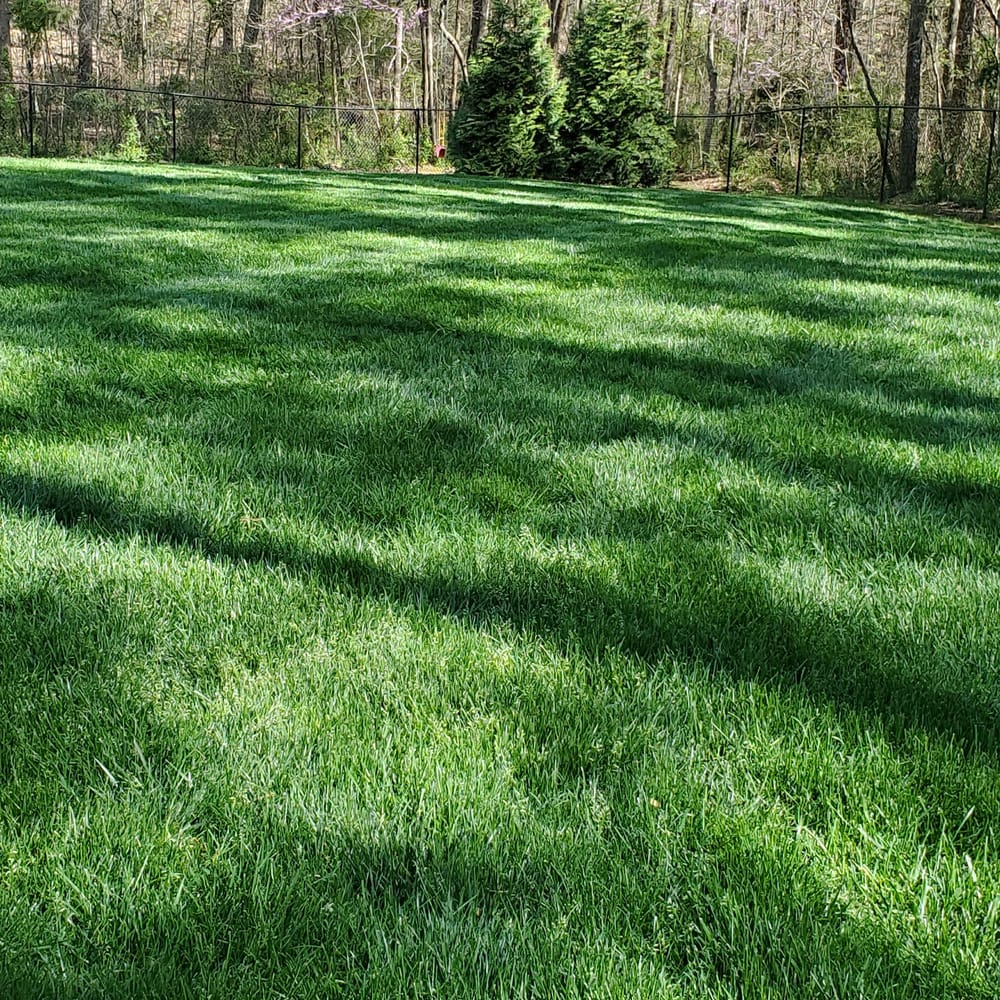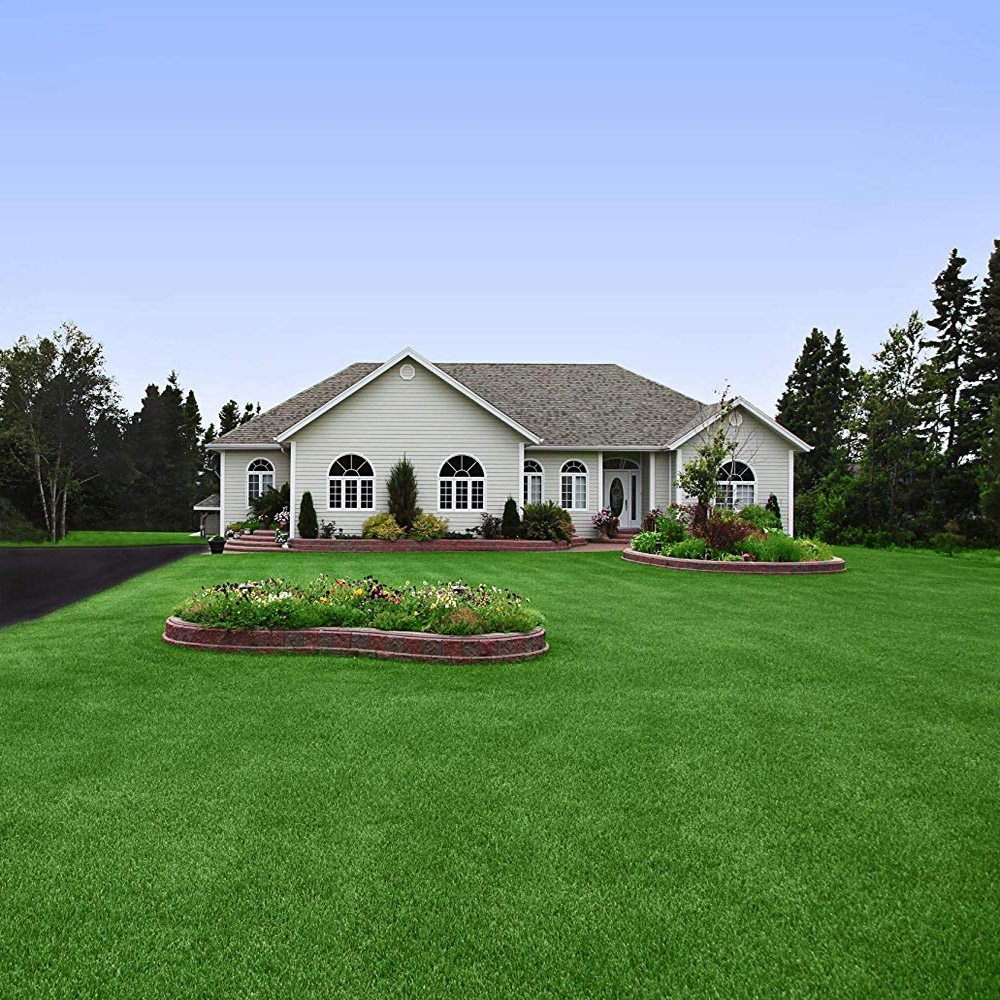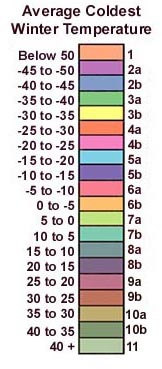
Kentucky Bluegrass - Midnight
- Dark Green Color
- Lawns
- Cost Efficient

Grasses used in Colorado are predominantly cool season grasses of which the most dominant is Kentucky Bluegrass.
Kentucky bluegrass is a high quality, sod forming, cool season, shallow-rooted grass with excellent appearance and recuperative potential. It may require frequent irrigation, tends to form thatch and is somewhat disease and insect prone. However, it is extremely cold tolerant and one of the most beautiful grasses there is. It also spreads by rhizomes which helps to repair itself and makes it fairly wear tolerant. Kentucky bluegrass is not the only cool season grass used in Colorado. Fescue and ryegrass are two other commonly used cool season grasses.
Tall fescues are bunching, cool season, deep-rooted grasses that may be more drought resistant. They have few insect or disease problems, are slow to form thatch, and do well in shade. They are slow to recover from divoting, can become clumpy if not carefully established.
Perennial ryegrasses are bunching cool season grasses that are compatible in appearance with bluegrass, do not form thatch, have good heat tolerance and may be drought resistant. They tend to be disease prone and offer poor freezing tolerance if flooded or exposed to wind.
Fine fescues are divided into Chewing fescues, Hard fescues, Red fescues and Sheep fescues. For our purposes they are all grouped together. They are bunching cool season grasses, have a fine leaf texture, offer good shade and cold tolerance, and will adapt to poor soil conditions and fertility. They are not heat tolerant, are susceptible to diseases, can become thatchy, and are difficult to mow.
Buffalograss (warm season grass) is a native grass that can be planted in an area that receives little or no water or care. Buffalo grass is a native variety that does well in this sort of situation. A warm-season grass, it becomes green in mid-to-late May, and becomes dormant again around late September when night temperatures again begin to freeze. Once established, it requires little supplemental water or fertilizer, is low-growing and therefore needs little mowing. It also stands up well to wear. is a sod forming, warm season, native grass that is extremely drought resistant. It is low growing and attractive in appearance with few disease and insect problems. Sound too good to be true? It is. We may be a little too high and have too short of a growing season for buffalograss to thrive. But if you have a warm, south facing location with heavy soil, it is well worth trying. It has the ability to go dormant under drought stress and then to quickly green up and resume growth once moisture becomes available. Native grass seed is expensive; buy only certified and treated seed.
Blue grama (warm season grass) is the dominant native grass that is optimally adapted to our area. It is a bunching, warm season grass with a fine texture. It can be somewhat sod forming if mowed occasionally to a three-inch height. It has excellent heat and drought resistance. Like Buffalograss, it is green only during the warm part of the year and shares the ability to recover quickly from drought stress. It is slow to germinate and establish, so it has limited applications for "quick" lawns. It may well be the grass of choice for a truly water efficient turf area.
Looking for a native grass that can be planted in an area that receives little or no water or care? Buffalo grass is a native variety that does well in this sort of situation. A warm-season grass, it becomes green in mid-to-late May, and becomes dormant again around late September when night temperatures again begin to freeze. Once established, it requires little supplemental water or fertilizer, is low-growing and therefore needs little mowing. It also stands up well to wear.
| Click Name To View Grass Seed Choice | Type | Applications | |
|---|---|---|---|
| Cool Season Mix - Showtime |
|
Cool Season |
Lawns - Full Sun to Moderate Shade Rye, Kentucky Bluegrass, Fine Fescue Mix |
| Cool Season Mix - Garland |
|
Cool Season |
Lawns - Full Sun to Moderate Shade Rye, Fine Fescue Mix |
| Fescue/Bluegrass Mix - Combat Extreme North |
|
Cool Season | Lawns - Wear Tolerant |
| Fescue Blend - Combat Extreme Transition |
|
Cool Season | Lawns - Wear Tolerant |
| Fine Fescue Blend - Legacy |
|
Cool Season | Lawns - Full Sun To Moderate Shade |
| Kentucky Bluegrass - Bluegrass Supreme |
|
Cool Season | Lawns - Golf Gourses - Full Sun |
| Kentucky Bluegrass - Midnight |
|
Cool Season | Lawns - Golf Courses - Full Sun |
| OSP Ryegrass |
|
Cool Season | Lawns - Golf Courses |
| Shade Grass - Poa Supina Mix |
|
Cool Season | Lawns - Full Sun - Deep Shade - Best Shade Grass |


Below is the USDA Zone Map for Colorado so you can determine which zone you reside in. Below that are our picks for your state which will do best in your area. Next on this page are tables which list various grasses and their characteristics so you can compare before you decide on your purchase. Click on the product name (ie. Midnight) for more information about that grass and to make your purchase.
| USDA Zone Map For Colorado | |
|---|---|
 |
 |
| Compare Various Grasses For Their Characteristics | ||||||||
|---|---|---|---|---|---|---|---|---|
| Cool Season Grasses |
Leaf Texture |
Establish Rate |
Nitrogen Use |
Water Use |
Drought Tolerance |
Salinity Tolerance |
Shade Tolerance |
|
| Bentgrass - Creeping | Fine | Moderate to Fast |
Low to Moderate |
High | Poor to Moderate |
High | Poor to Moderate |
|
| Bentgrass - Colonial | Fine | Moderate to Fast |
Low | Moderate | Poor to Moderate |
Moderate | Moderate | |
| Bluegrass - Kentucky | Moderate to Fine |
Slow | Moderate to High |
Moderate to High |
Good | Moderate | Poor | |
| Bluegrass - Rough | Moderate to Fine |
Slow | Moderate to High |
Moderate to High |
Poor | Moderate | Excellent | |
| Fescue - Hard | Fine | Slow to Moderate |
Low to Very Low |
Moderate | Excellent | Low to Moderate |
Excellent | |
| Fescue - Creeping | Fine | Moderate | Low to Moderate |
Moderate | Good | Low | Excellent | |
| Fescue - Turf Type | Moderate to Coarse |
Moderate | Moderate to High |
Low to Moderate |
Excellent | Low | Good to Excellent |
|
| Ryegrass - Perennial | Fine to Moderate |
Very Fast | Moderate to High |
Moderate to High |
Good | Poor to Moderate |
Poor to Moderate |
|
| Compare Various Grasses For Their Characteristics - Continued | ||||||||
|---|---|---|---|---|---|---|---|---|
| Cool Season Grasses |
Fertility Needs |
Wear Resistance |
Mowing Height |
Cold Tolerance |
Acid Soil Tolerance |
Thatching Tendency |
Heat Tolerance |
|
| Bentgrass - Creeping | High | Low | Low | Low | Medium to High |
High | High | |
| Bentgrass - Colonial | High | Low | Low | Low | Medium to High |
High | High | |
| Bluegrass - Kentucky | Medium | Medium to High |
Medium | High | Medium | Medium | Medium | |
| Bluegrass - Rough | Medium | Medium | Medium | High | Medium | Medium | Medium | |
| Fescue - Hard | Low | Low | Medium | Medium to High |
Medium to High |
Low to Medium |
Low to Medium |
|
| Fescue - Creeping | Low | Low | Medium | High | Medium to High |
Low to Medium |
Low to Medium |
|
| Ryegrass - Perennial | Medium | High | Low to Medium |
Medium | Medium | Low | Medium to High |
|